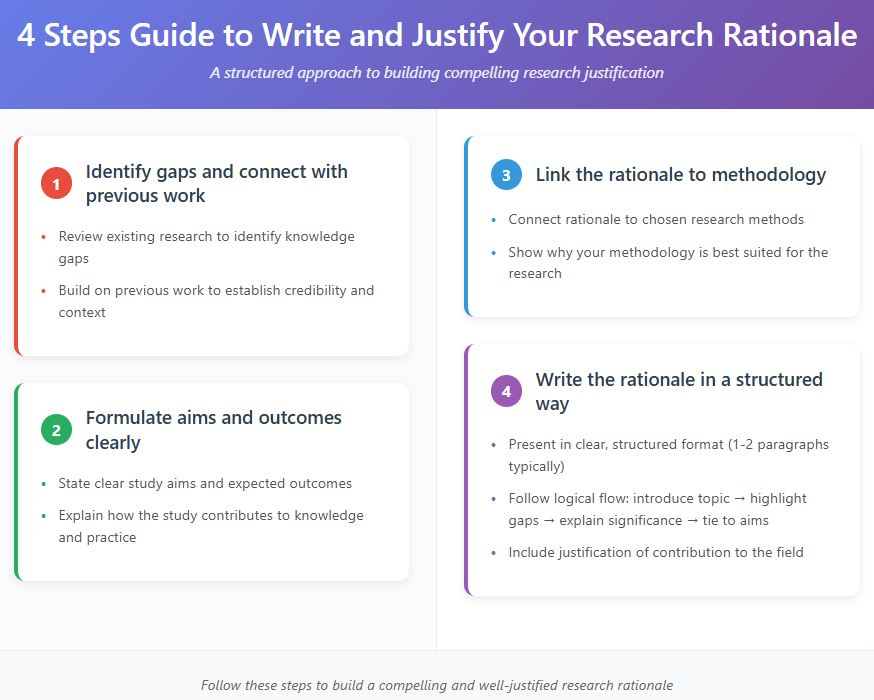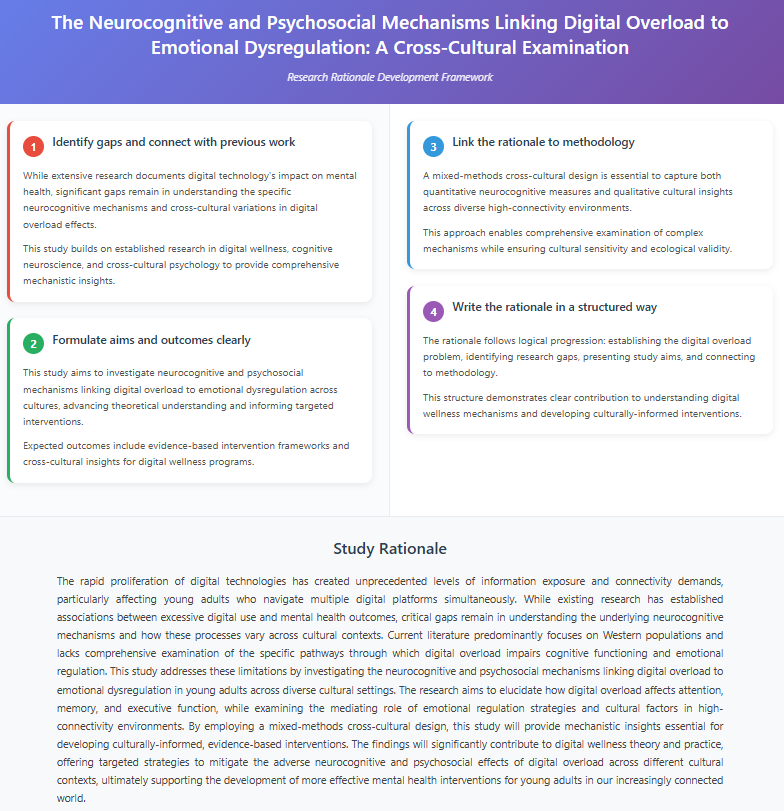What Is the Rationale of the Study?
Definition and Purpose of a Research Rationale
- Clear meaning: The rationale of the study is the explanation of why a particular research project is necessary and valuable.
- Research rationale: It sets the background and context by linking the research question to existing knowledge and previous research.
- Justification: By providing justification, it shows that the study is not random but grounded in academic reasoning.
- Purpose:
- To highlight the gap in knowledge that your research paper, thesis, or dissertation will address.
- To explain how your objective and aim align with solving real issues.
- To convince examiners, supervisors, and readers that your work is worth the effort.
Get Expert Dissertation Support
Boost your success with Elite Thesis Help. Our experts guide you in crafting a strong rationale of the study and more. Start your dissertation journey today!
How a Study Rationale Justifies the Need for Research
- Demonstrates importance: The rationale of the study provides reasons why the topic matters in academic, professional, or social contexts.
- Basis for writing: When you write the rationale, you must:
- Show the gap in previous research.
- Explain how your study will justify new knowledge or practical solutions.
- Demonstrate how your work will help in formulating better theories, practices, or policies.
- Connection to literature review:
- The literature review helps identify areas that require more investigation.
- The rationale then outlines how your research proposal addresses those gaps.
- Practicality: A strong rationale gives your supervisors confidence that you can successfully conduct the research project.

4 Steps Guide to Write and Justify Your Research Rationale
- Identify gaps and connect with previous work
- Begin by reviewing previous research and current knowledge in your field of study.
- The literature review will help show what is missing.
- This review will help you identify gaps that your rationale of the study can address.
- By building on previous research, you create a credible basis for writing and show how your study is part of the big picture.
- Formulate aims and outcomes clearly
- State the study aims and expected outcomes.
- Use precise language to clarify aims and objectives.
- A compelling research rationale explains how the study will contribute to knowledge and practice.
- If taking a novel or unconventional approach, note that this might warrant a longer description and a longer and more detailed justification.
- Link the rationale to methodology
- The rationale is typically presented before outlining the methodology.
- Clearly link the rationale to chosen methods by showing why they are best suited.
- Whether qualitative, quantitative, or mixed, the methodological choices must flow logically from the rationale for your research.
- This adds credibility and shows the reader why your study design is valid.
- Write the rationale in a structured way
- Ensure the rationale is presented in a research article, research paper, thesis, or dissertation in a clear and structured format.
- Usually written as one to two paragraphs in shorter works, or as a longer description in doctoral studies.
- Keep the structure logical: introduce the research topic, highlight the gaps or issues, explain the novelty or significance, then show how your study rationale ties to aims and objectives.
- Always include a justification of the potential contribution to the field.
Ideal Length of the Research Rationale
- Balance of detail: The rationale of the study should not be too short or too long—just enough to convince the reader.
- In a research paper: Often one to two paragraphs, focusing on the objective and justification.
- In a dissertation or thesis:
- Can be longer (one to two pages).
- Explains how your research question emerges from the gap in previous research.
- Links the aim and outcome of the study clearly.
- Key factors affecting length:
- The type of research project (small assignment vs. full dissertation).
- The depth of the justification required.
- The expectations of your supervisor or institution.
- Practical advice:
- Always align the length with the scope of the work.
- Keep sentences clear and avoid unnecessary detail.
- Remember that the aim is to write a rationale that is concise yet convincing.
How to Write the Rationale for a Research Paper or Dissertation
Basis for Writing a Rationale
- Foundation of the study: The rationale of the study provides the underlying explanation of why a research project matters in the chosen field of study.
- Justification: A strong rationale for research offers a detailed justification of the research topic by demonstrating its relevance, originality, and connection to current knowledge.
- Purpose:
- To clarify the study aims and objectives.
- To explain why you focused on a specific phenomenon rather than others.
- To show how the study justifies the need for further exploration.
- Basis for writing:
- A researcher begins with a problem statement, then develops the study rationale as part of a plan of your work.
- The literature review will help you identify gaps or issues in existing literature.
- From there, the rationale is presented logically to highlight how the study is completed to fill those gaps.
- Flexibility: The rationale for a research paper may be short (a couple of paragraphs), but in a PhD dissertation to explain the scope of the study, it can be a longer and more detailed justification.
Example of How to Connect the Research Topic, Research Questions, Objectives, and Rationale of the Study
Title: The Neurocognitive and Psychosocial Mechanisms Linking Digital Overload to Emotional Dysregulation: A Cross-Cultural Examination of Young Adults in High-Connectivity Environments
Research Aim
To investigate the neurocognitive and psychosocial mechanisms through which digital overload contributes to emotional dysregulation in young adults, and to compare how these processes manifest across different cultural contexts in high-connectivity environments.

Research Objectives
- To examine the neurocognitive effects of digital overload on attention, memory, and executive function in young adults.
- To explore the psychosocial pathways through which digital overload influences stress, anxiety, loneliness, and emotional well-being.
- To analyze the role of emotional regulation strategies (e.g., mindfulness, cognitive reappraisal, avoidance) in mediating the relationship between digital overload and psychological outcomes.
- To conduct a cross-cultural comparison of these mechanisms between young adults in societies with differing cultural norms and digital infrastructures.
- To propose evidence-based interventions aimed at mitigating the adverse psychological and neurocognitive effects of digital overload.
Research Questions
- How does digital overload affect neurocognitive processes such as attention, memory, and executive functioning in young adults?
- What psychosocial mechanisms (e.g., perceived stress, anxiety, loneliness, social support) mediate the relationship between digital overload and emotional dysregulation?
- In what ways do emotional regulation strategies influence the impact of digital overload on mental health outcomes?
- How do cultural differences shape the relationship between digital overload, neurocognitive functioning, and psychosocial well-being in young adults living in high-connectivity environments?
- What interventions or coping strategies can be developed to reduce the negative neurocognitive and psychosocial impacts of digital overload across different cultural contexts?
Rationale of the Study
The rapid proliferation of digital technologies has created unprecedented levels of information exposure and connectivity demands, particularly affecting young adults who navigate multiple digital platforms simultaneously. While existing research has established associations between excessive digital use and mental health outcomes, critical gaps remain in understanding the underlying neurocognitive mechanisms and how these processes vary across cultural contexts. Current literature predominantly focuses on Western populations and lacks comprehensive examination of the specific pathways through which digital overload impairs cognitive functioning and emotional regulation. This study addresses these limitations by investigating the neurocognitive and psychosocial mechanisms linking digital overload to emotional dysregulation in young adults across diverse cultural settings. The research aims to elucidate how digital overload affects attention, memory, and executive function, while examining the mediating role of emotional regulation strategies and cultural factors in high-connectivity environments. By employing a mixed-methods cross-cultural design, this study will provide mechanistic insights essential for developing culturally-informed, evidence-based interventions. The findings will significantly contribute to digital wellness theory and practice, offering targeted strategies to mitigate the adverse neurocognitive and psychosocial effects of digital overload across different cultural contexts, ultimately supporting the development of more effective mental health interventions for young adults in our increasingly connected world.
Other Examples of Rationale for a Research Paper and Dissertation
- In a research paper:
- The rationale for a research paper is usually brief.
- Example: “The purpose of this research article is to examine the relationship between stress and sleep in university students. Although previous research has explored stress, there is limited understanding of how it affects sleep quality in the UK context. This rationale of the study clarifies the gap and justifies the need for specific research.”
- Here, the rationale is presented in one concise paragraph showing the justification.
- In a dissertation:
- The rationale of the study in a PhD dissertation to explain the plan of your work will be more extensive.
- Example: “This dissertation aims to investigate the use of artificial intelligence in healthcare diagnosis. The rationale of the study is based on the gap between the rapid adoption of AI and the lack of evidence on its ethical use in practice. This study rationale justifies the need for detailed investigation by linking to existing literature, providing preliminary data, and setting clear aims and outcomes. The rationale is presented in a longer description, offering a detailed justification and highlighting the contribution to the field.”
- In such cases, the rationale for research goes beyond two paragraphs and includes theoretical discussion, methodological considerations, and sometimes even preliminary data.
